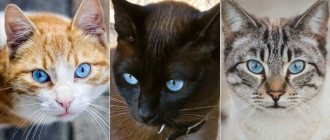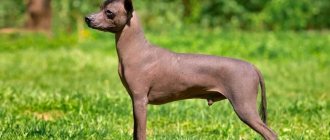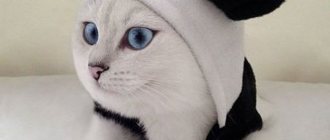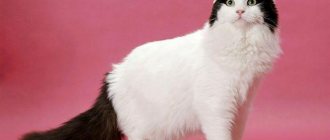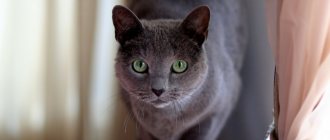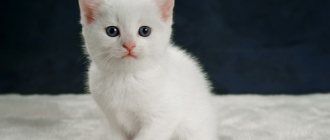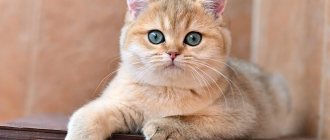Breeds of cats with blue eyes are developed thanks to the knowledge of genetics. There are a large number of such types. These animals have different coat lengths, but they are usually divided as follows according to color:
- epistatically white;
- bicolor: a combination of a snow-white shade with another;
- acromelanistic (temperature-dependent) color.
Such animals are found in all groups of breeds: longhaired, semi-longhaired, shorthaired, Siamese-oriental, hairless.
The most beautiful blue-eyed cat Kobe
Features of black cats
The pigment melanin is responsible for the formation of skin and coat color. There are two types of it: eumelanin and pheomelanin. Both pigments differ in structure.
The grains of the first have a spherical shape, due to which they absorb light and produce black pigment and all its derivatives - chocolate, lilac, blue, fawn. Pheomelanin grains reflect light in the red range and are responsible for this color and all its varieties.
Color is inherited depending on gender, since the gene is located on the X chromosome, it is not on the Y chromosome.
A male with one X chromosome can carry black or red. A female with two X chromosomes carries three color options (red, black, tortoiseshell).
The genes responsible for color are passed on to the son through the maternal line. A black cat cannot produce a red cat, and a red female will never produce a black male.
Character
Black cats have highly developed empathy; they feel the owner’s mood swings, his emotional and physical state. These purrs know how to amuse and heal.
Animals are tolerant of children's antics, are not prone to aggression, easily adapt to circumstances, and quickly recover from stress.
It is generally accepted that blackies are weather sensitive. By observing the behavior of their pets, owners learned to predict weather changes. There are cases when black cats warned their owners about the approaching earthquake. Showing concern, the animals forced people to leave their homes.
Advantages and disadvantages
Advantages:
- flexible disposition;
- responsiveness;
- peacefulness;
- attractive appearance;
- empathy.
Cats with black fur have no objective disadvantages.
Bicolors with genetically linked blue eyes
There are only two such breeds: Ojos Azules (Spanish) and Altai Blue-Eyes (native to the Russian Federation), these cats can have short and semi-long hair.
Ojos Azules
Both cat breeds are very rare and are not recognized by official international felinological systems; breeding work with these breeds is carried out at the experimental stage.
In both breeds, blue eyes are associated with the white spotting gene, that is, the color outside of white can be any color, but the eyes are only blue. Enthusiasts are breeding to reduce the amount of white hair in order to obtain a blue-eyed cat with a few white hairs.
Color options
According to international standards, the black color is assigned the code n (sil, wild, ebony, sable). The guard hairs and undercoat should have a uniform color: each hair is completely dyed, without colored or white inclusions.
The nose, paw pads, and whiskers must be exclusively black.
Possible eye colors
The iris of the eyes often plays with all shades of yellow and green: bright emerald, bright green, orange, olive, light sand.
Reference. Black kittens are born with blue irises.
Acromelanistic (Siamese or pointing) colors
Siamese cat: an elegant beauty with cornflower blue eyes, has won the hearts of many cat lovers. Here, blue eye color is genetically associated with a color in which the body remains light (ideally almost white), and only the “points” - limbs, ears, muzzle, tail - will be colored.
The Siamese color was introduced by interbreeding into many other breeds - Persian (in American feline systems, a Persian cat of Siamese color is called Himalayan), British shorthair and longhair, Scottish fold and straight, Highland fold and straight, in Rex breeds (cats with curly hair), into hairless (Sphynx) cat breeds.
Aboriginal breeds are free from the Siamese color gene, with the exception of Siberians, where this color is recognized, as well as monochrome and painted ones.
When a bicolor color is superimposed on the Siamese color gene, we get the Sacred Burmese breed (belongs to the long-haired group), and the Snow Shoe, a Siamese-oriental breed.
Separately in the Siamese-Oriental group of breeds stands the Forinwhite - in Siamese - an elegant white cat with blue eyes and delicate silky fur without undercoat. The Foreign White was obtained through selection by crossing a Siamese cat (blue eyes) with a white Oriental.
Top best black cat breeds
There are no exclusively black cat breeds in nature. These include perhaps a variety of Burmese cats - the Mandalay breed. This bright black beauty with piercing yellow eyes has not yet been recognized by international organizations, however, due to the growing popularity of the Burmese, we can expect their official recognition in the near future.
Black colors are found in the following breeds: Maine Coon, British and Scottish cats, American Curl, Bombay, Manx, Chausie, Cymric.
Persians and Egyptian Mau are characterized by smoky colors: the tips of the hairs are dark gray or black, and the base is light.
Bombay
The only cat breed whose standard allows only black color. Externally, the animals resemble a panther. The breed was developed in the USA in the 50s. XX century. The coat should be dark, without streaks or marks. The nose and paw pads are only black.
Kittens are born with blue eyes. As animals mature, the iris turns gray and then acquires a rich golden-amber hue.
Persian
The color variability of Persians is amazing. One of them is raven color, without red. The undercoat is slightly shorter, but the shade is the same. The coat is luxurious, long, iridescent. Paw pads and nose are black-brown or black. The skin has a gray-blue tint. The iris of the eyes is dark orange or deep copper.
The fur is thick and easily tangled, so it needs regular brushing. A lush collar adorns the neck, shoulders and chest.
Devon rex
A young breed of English origin. One of the color options is black with a gray or blue tint. At the same time, the coat is very short, soft, curly, without hard guard hairs. The eyes are slanting, expressive, of any color: golden, green, yellow, hazel, orange, olive.
The black color is also included in other colors: mackerel, silver-black, tabby, bicolor.
American Bobtail
Short-tailed cat of American origin. There are various shades of black: ash, charcoal, dark chocolate. The eyes are large, almond-shaped, hazel, green, and light yellow in color. The nose and paw pads are black or dark brown.
The American Bobtail is closely related to the Kurilian Bobtail. The breed received official recognition in 1989, although the breed characteristics were established in the 60s. gg. XX century. Representatives of the breed have strong bones and a powerful build. The character is flexible, which makes the “Americans” everyone’s favorites.
Norwegian forest
The Norwegian Forest Cat is a real beauty, the national pride of the United States, and has an external resemblance to the Siberian cat. There are numerous colors, but the most spectacular is black. The iris of the eyes can be green, amber, hazel, or golden.
The coat is thick, double, repels water well, the neck is decorated with a “collar”, and the hind limbs are decorated with “socks”.
A fur collar on the neck protects from severe frosts, and powerful paws help to move quickly. The Norwegian Forest loves freedom and is suitable as a companion for those who will not limit its actions.
Manx
Representatives of the breed are born with short tails or without them at all. The coat is two-layered, the black guard hair is lined with a dense dark-colored undercoat. The iris is colored in yellow and orange shades. The nose and paw pads are also black.
The dark color is variable: tabby (dark stripes on gray or fawn), smoky, dark chocolate, dark gray.
Maine Coon
The Maine Coon is a large cat with a long, smooth coat. The black color is deep and rich. The skin is gray or light with a blue tint. The paw and nose pads are deep black. The iris is copper or red.
Pure color is rare; often the fur coat has a dark striped, marbled, spotted pattern.
Maine Coons love to be the center of attention and interact with family members. Animals are extremely delicate, do not impose themselves, and do not get underfoot.
British
The British cat is better known by its blue color. The image of a gray plush murka appears in the head when the breed is mentioned. The animal's fur is thick and soft to the touch. The length of the undercoat coincides with the length of the guard hairs, the black tone looks velvety and deep.
The British have a yellow-orange iris. Available shades range from nut to bright orange. The nose and paw pads are black or a shade lighter.
Reference. The peculiarity of plush fur is its complete absorption of color.
Scottish
A distinctive feature of the Scottish Fold cat is its round head, flattened muzzle and drooping ears. The wool is fluffy, “cloudy”, very soft and pleasant to the touch. There are 1-3 folds on the ears. Black color is rare.
It is considered real luck to have a charming Scotsman with resinous fur. The irises of the eyes are the same as those of the British - the color varies from hazel to bright orange.
Siberian cat
The Siberian cat is large, fluffy, with massive bones. There are many color options, but black is the least common color. The dark color is rich and deep. The fur is dense, the undercoat is double. There is a frill on the chest, and pants on the hind legs. The tail is luxurious, anthracite in color, fluffy, like a broom. The iris is yellow with a light edging.
The density of the undercoat varies depending on the time of year: in spring and summer it is short, in winter and autumn it is fluffy and long.
The neck is framed by a lush “collar”, on the hind legs there are wide “pants”, the tail is pubescent in a plume type.
Oriental cat
Impressive, refined, graceful - this is how you can characterize the Oriental cat. The short fur is blue-black, the nose and paw pads are blue-black. The structure of the fur is soft, pleasant to the touch, and has a precious shimmer.
The dark color of the Oriental is called ebony, which translates as ebony. Against the background of such a luxurious coat color, the green iris of the eyes looks wonderful. In addition, Orientals also have yellow eyes. .
Sphinxes
When the body of the Canadian, Don, and St. Petersburg Sphynx produces euomelamamine in excess, the skin of cats becomes dark gray, or rather the color of wet asphalt.
Don Sphynx
Cymric
Cymrik is a good-natured creature with a fluffy coat. The guard hairs and undercoat are the same length. The dark color is closer to charcoal purple.
The cats are called little bears due to their thick fur, compact build, round muzzle and short tail.
Chausie
The Chausie is one of the largest hybrid breeds. Dark color - solid black and black grizzly (salt and pepper).
When breeding the breed, breeders used the Abyssinian cat and the jungle cat. The presentation of the chausie took place in 1990. These cats are endowed with natural grace and a peaceful disposition.
Bengal
The Bengal's coat is dense, short, and silky. The charcoal color of the Bengal is not yet included in the breed standard. Animals with such colors look gorgeous. Under sunlight or artificial lighting, dark spots and rosettes are visible on the shiny black fur.
Bengals are playful, inquisitive, affectionate and calm.
Are blue eyes in cats rare or an exception?
A snow-white kitten with aquamarine eyes is the dream of many lovers of these graceful animals. Having decided to search for such a pet, you need to understand that this process will not be quick, much less free. The fact is that cats usually have a medium number of melanocytes in their bodies, which are responsible for the color of the iris.
This is why there are so many green-eyed cats in the world (with just the average number of melanocytes). A high content of this pigment will give a brown tint to the eyes, and a low content will give the much-desired heavenly color. Note that there are hardly two blue-eyed cats whose shade of blue will be the same. Like people, cats have different gradations of eye color - from icy, blue-white to deep blue. The last shade is practically not found in representatives of the cat family.
Persian kitten with an angelic appearance
Why do cats have blue eyes?
There are three reasons that influence the appearance of blue eyes in a kitten. These factors exist independently, without intersecting with each other.
Table. Causes of blue eyes in cats
| Cause | Description |
| Dominant gene | The first includes the dominant white W gene present in the animal. The fact is that blue-eyed cats are often white cats or cats in which the snow-white shade occupies the majority of their entire color. However, such cats often have hearing problems, even complete deafness. The W gene is also to blame for this. It simultaneously “gives” the animal aquamarine eyes, but reduces hearing acuity. It is not always worth worrying about the health of a white blue-eyed cat, because a dominant gene can only affect the animal’s hearing, but it does not necessarily manifest itself in a negative way. However, even if the kitten was born deaf, this will have little effect on life with a loving owner, since the animal will orient itself thanks to other organs - smell and vision. |
| Genetic code | The second factor is a special genetic code (SACA), due to which animals are called albinos. Usually, when you hear the word “albino,” you imagine a light-colored creature with red eyes, but in cats, this combination of genes gives just blue eyes. However, the gene code makes itself felt, and therefore the blue eyes of albino cats, if you look at them in the dark or, conversely, when directly exposed to bright light, will glow pinkish or red. |
| Coat color on face | Another factor is the white spots on the animal’s face. If white fur extends into the eye area, there is a chance that the iris will “intercept” the dominant W gene, which we discussed above. But, as you can understand, the cat in this case may be blue-eyed or have heterochromia (eyes of different colors, for example, green and blue), but it will not be completely snow-white. |
Albino kitten
There is also a separate breed of cats whose eyes are only blue. The breed is called Ojos Azules, which translates from Spanish as “blue eyes.” These are unique cats that can have any coat color, but their eyes remain a heavenly shade. At the same time, representatives of the Ojos Azules breed are prohibited from crossing with other cats, since there is a high probability of a gene error, and the kittens may be born dead or have mutations in the skull.
Ojos Azules cat
Breeds of long-haired black cats
List of long-haired black cat breeds:
- Neva Masquerade;
- Siberian;
- Maine Coon;
- British Longhair;
- Persian;
- American Bobtail.
Shorthair
List of shorthaired breeds with dark coats:
- chausie;
- Bengali;
- oriental;
- Cymric;
- Manx;
- British Shorthair;
- Scottish lop-eared;
- Devon Rex;
- Bombay.
Bald
Hairless cat breeds are hairless, but such animals have dark skin. These are the Peterbald, Don and Canadian Sphynxes. In elves, Ukrainian Levkoy, Dwelf, Minskin, dark skin color is less common.
Mr. Cat advises: breeds not included in the TOP
There are equally beautiful cat breeds that are not included in the TOP:
- British Shorthair: Comes in a variety of colors. Their muzzle is rounded with large cheeks. The eye tone is light blue. Cats are strong and muscular, and have large dimensions. They prefer to walk rather than climb.
- Scottish Fold: Scottish Folds have varied coat colors. The iris can be a different blue tone. It acquires its final color by the age of one year.
- White Persians: This fluffy breed (with blue eyes) is very rare, prized and worth a lot of money. Often cats of this species are born deaf.
- Devon Rex: Has soft, curly fur, large ears, and a long muzzle with high cheekbones. The animal is characterized by rapid mood changes.
- Russian White: has a silky coat of medium length. The animal's physique is fragile. Temperament is calm. Eyes can be blue, amber, green.
- White Sphynx: the animal is hypoallergenic due to the lack of hair. A sign of the purebred breed is light pink skin and blue eyes. Cats of this species require careful care. They feel comfortable only at home, next to their owner.
- Kao Mani: the breed is young, unstable. Geneticists are working on this. The animal loves people and trusts everyone without exception. His fur is short and shiny. The undercoat is weak or absent.
Each cat has its own characteristics and temperament.
Choosing a pet must be taken seriously. Understand what responsibility will be placed on your shoulders. Any pet needs to be given enough attention, especially purebred ones.
Nuances of care
Caring for cats depends on the length and thickness of the coat, the presence or absence of undercoat. A long, luxurious fur coat needs careful care. The purr with its undercoat must be combed regularly, especially in winter, when the fur grows intensively under the influence of heating devices. The same applies to periods of seasonal molting.
Hairless cats have nothing to comb; instead, owners should pay due attention to moisturizing the skin and removing sebum and sweat.
Breeders recommend accustoming animals to hygiene procedures from an early age, so that later bathing and brushing do not cause aggression.
Cats with thick undercoat are brushed with a furminator twice a week. The tool easily removes fluff, and animals do not perceive the procedure as an execution.
Persians are brushed with a slicker brush due to the special structure of their coat. The tool untangles but does not pull out airy cat fur.
It is not advisable to neglect the procedure for combing long-haired cats, because their hairs often become tangled, and the tangles then have to be cut off.
To maintain healthy coat and skin, veterinarians advise adding vitamin and mineral complexes to the diet.
Characteristic diseases
Representatives of aboriginal breeds (Siberian cat, Maine Coon, Neva Masquerade cat) have excellent health and rarely suffer from infectious diseases.
Breeds bred by breeders are prone to genetic diseases. For example, Scottish Fold cats suffer from cardiovascular diseases and have kidney problems.
Persians have difficulty breathing due to the incorrect structure of the nasal septum; diseases such as:
- retinal atrophy;
- viral rhinotracheitis;
- renal failure;
- hypertrophic cardiomyopathy.
Orientals suffer from gastrointestinal diseases, bronchial asthma, heart pathologies, retinal atrophy, and strabismus.
The Sphynx is often diagnosed with urticaria. And this is not surprising, because his delicate skin is very sensitive. The Don Sphynx is treated for acne, seasonal dermatitis, lichen and dermatophytosis, corneal ulcers, conjunctivitis and scleritis.
Khao mani
The history of this breed, whose name means "white gem" or "white pearl", is romantic and hazy, with connections to Thailand, royalty and ancient manuscripts. It appeared on the felinological stage no earlier than 20 years ago, and is still very rare.
Cats with blue eyes of the Khao Mani breed have short white hair - and this differs from the same Angora. Also, according to the standard, kao mani have amber, green or multi-colored eyes.
Signs about black cats
A black cat crossing the road is a harbinger of bad luck. This belief is actively circulating by word of mouth in the post-Soviet space, some European countries and the USA. But for a resident of Great Britain and Japan, this portends a good sign and unexpected joy. If you still believe in folk omens, if you meet a black cat on the road, spit three times over your left shoulder or grab a button.
The British believe that a black cat protects a person’s home from thieves, and also helps single women find their soulmate.
A cat sitting on the threshold needs to be let into the house and warmed up - in gratitude it will attract wealth and peace into the house. The animal cannot be driven away. In any case, such behavior characterizes a person from the bad side.
If a cat gives birth to red and black kittens, according to popular belief, it is better to place the red one in good hands, and leave the black one in the house for good luck.
If a black cat sneezed not far from the bride, it means the marriage will be happy.
In ancient times, black cats were kept in temples and were considered amulets.
This is interesting! In the Middle Ages they believed that a cat was an enchanted witch. Women who dared to have a black animal were burned at the stake.
The Chinese, on the contrary, warded off evil spirits with the help of cats.
Scandinavian fishermen took fluffy animals on boats, thereby insuring themselves against storms.
The Slavs were not afraid of pitch-black cats, but, on the contrary, attracted them to their homes. The mustaches quickly caught mice.
As you can see, there are not so few good omens. What to believe is the choice of each of you. The main thing is not to forget that animals should not suffer from prejudice, because kushki do not spread negative energy and do not wish harm to anyone.
History of the breed
Its first example was found in the 60s of the 20th century. It was in provincial Scotland, in farming. A wild tabby cat gave birth to a kitten from an unknown father. The baby was named Susie, she had small curled ears.
Over time, she began to give birth to kittens often, so the owners of the farm distributed the babies to their comrades and fellow villagers. And one day such a Scottish Fold ended up with Lady Mary Ross. Tu was intrigued by the animal’s unique exterior.
See also what British fold kittens look like in the photo.
Not being a real felinologist, she, after consulting with professionals, decided to create an unusual breed. For this purpose, she arranged a mating of a fold-eared cat with a British female with short fur. She set up their daughter with a gay British man. And as a result, the first examples of the Scottish Fold breed were born, which had unusual ears. See all photos of Scottish folds.
There is another theory about the appearance of the Scottish Fold. They have been known from it since the 19th century. This fact is clear from the notes of Charles Darwin, in which he describes cats from China with folded ears.
The 70s of the 20th century were marked by a ban on scientists breeding individuals with drooping ears. This was explained by the fact that cats with similar ears have problems removing ticks. In addition, experts found that the furry babies being born could not hear normally.
Having such problems, breeders have done a lot of work to help get rid of them.
Scottish Folds were also banned due to a number of serious illnesses affecting these cats. Some suffered from fusion of spinal discs, others had crooked legs. Genetic specialists again needed to correct the flaws.
During the experiments, they found that animals with curved ears should only be mated with straight-eared individuals. The result of this approach was fluffy babies with curled ears (Scottish Fold) and with protruding ears (Scottish Straight).
Signs and superstitions
Gray cats in the eyes of people are almost the same mystical creatures as black ones. Gray is the color of fog, hiding from view what lies ahead, a symbol of an uncertain future and secrets. Ash-colored cats have their own signs and superstitions:
- A gray cat lures money into the house.
- Brownies love gray cats most of all. If you need to make friends with the spirit of your home, you should get just such a pet.
- Blue cats know how to ward off negative magical effects on the house or owners.
- If a gray cat has found its way to the house, you cannot drive it away. Most likely, he came to protect the family from an evil eye or damage.
- If the gray cat runs away, the owners will be in trouble.
- If in the morning, as soon as you wake up, the first thing you do is stroke a cat with ashy fur, the whole day will be successful.
- Cats with blue skin promote peace in the family and the establishment of good relationships between its members.
- Unlike black cats, they only cross the road for good luck.
Teddy Scotsman or airy Persian? Aristocratic Russian blue or stylish Egyptian? Terrible Maine Coon or sophisticated Oriental? There are many handsome gray dogs of different breeds and they are all so good that making a choice is not easy. And although this color is associated with despondency, boredom and dullness, the gray cat is a bright and spectacular animal.
Features and genetics of color
The blue shade of wool is a lightened version of black. It manifests itself when certain conditions are met, which is why there are much fewer gray cats than patterned or dark ones. To obtain blue coat color, the kittens need to inherit from both parents the lightening gene and the non-agouti gene, which is responsible for suppressing the manifestation of the pattern.
In addition to the completely gray color, which completely lacks red pigment, cats have a so-called lilac color. Individuals with this coat have a dominant “red” gene, which gives their coat a warm tint.
From a genetic point of view, gray cats have a dominant black gene B (Black), diluted with a recessive light gene d. Under the influence of the latter, the carbon pigment zumelanin is unevenly distributed in the hairs. White spaces appear between the sticky granules, which create a brightening effect. The more black pigment a cat's hair has, the darker the color and vice versa.
Sometimes a mutation occurs in which charcoal is concentrated in the lower part of the hair, and its tip is colored white and vice versa.
Temperament and behavior
No matter what breed a black cat belongs to, it will always be sociable and cheerful. Owners of such pets note their openness and loving nature. These animals get along well with children and generally get along with everyone in the household.
Black cats are active, playful and do not like to sit in one place for a long time. They prefer to spend time actively; they simply need to move. As a kitten, an animal in a dark fur coat will endlessly chase a ball, and as it grows up, it will begin to switch to larger objects. With age, black cats' hunting instinct becomes more intense, and their physical activity only increases from this.
What are the differences between albino cats?
Albino cats have no pigment in their bodies. Such animals' eyes may have a blue tint, but in bright light or in the dark their reflection is only red.
The skin of albinos is an even light pink color, and the fur does not have even minor inclusions of dark hairs.
The health of these pets is usually not much different from ordinary cats. The absence of pigment in the body does not cause disturbances in the functioning of internal organs and does not increase the tendency to cancer. With proper care, an albino cat will live a full life.
